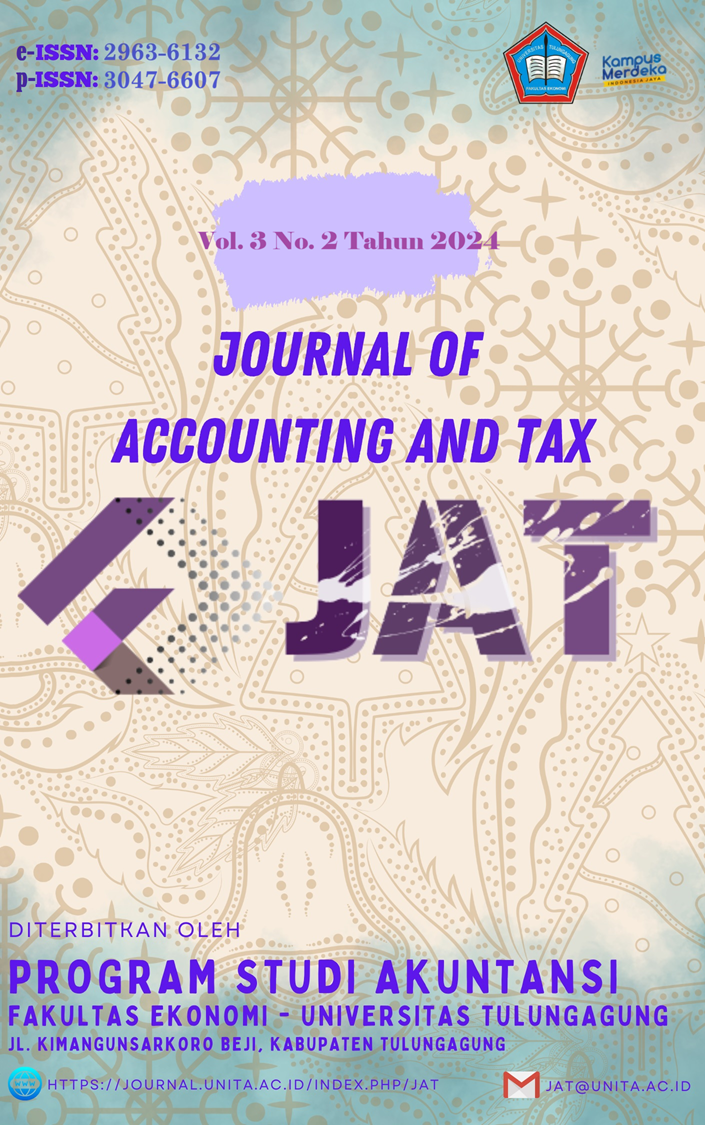UNLOCKING FINANCIAL INSIGHTS: EVALUATING PERFORMANCE THROUGH KEY RATIOS
DOI:
https://doi.org/10.36563/jat.v3i2.1352Keywords:
financial performance, liquidity ratios, activity ratios, solvency ratios, profitability ratiosAbstract
This study analyzes the financial performance of Pabrik Gula Modjopanggoong through key financial ratios, including liquidity, activity, solvency, and profitability. Using financial data from 2019 to 2023, the study employs a descriptive quantitative approach to evaluate the company’s financial stability and operational efficiency. The findings reveal that liquidity ratios, such as Current Ratio and Quick Ratio, fall below industry standards, reflecting challenges in meeting short-term obligations. Activity ratios demonstrate poor asset utilization, with a low Total Asset Turnover (TATO), although inventory management, as measured by Inventory Turnover (ITO), is efficient. Solvency ratios, including Debt-to-Equity Ratio (DER) and Debt-to-Asset Ratio (DAR), show favorable values, indicating minimal reliance on debt. However, profitability ratios, such as Net Profit Margin (NPM) and Return on Assets (ROA), are suboptimal due to declining sales and high operational costs. These results highlight the need for improved asset management and operational strategies to enhance profitability and competitiveness. The study provides actionable insights for optimizing financial performance and ensuring long-term sustainability.
Downloads
References
Albrecht, W. S., Stice, E. K., Stice, J. D., & Skousen, K. F. (2020). Financial Accounting. Cengage Learning.
Al-Malkawi, H. A. N., Bhatti, M. I., & Magableh, S. I. (2014). Analyzing Financial Performance Using Ratios. International Journal of Business and Finance Management Research, 2, 1-14.
Altman, E. I. (1968). Financial Ratios, Discriminant Analysis and the Prediction of Corporate Bankruptcy. Journal of Finance, 23(4), 589-609.
Atrill, P., & McLaney, E. (2020). Accounting and Finance for Non-Specialists. Pearson Education.
Beaver, W. H. (1966). Financial Ratios as Predictors of Failure. Journal of Accounting Research, 4, 71-111.
Bhimani, A., Datar, S., Horngren, C., & Rajan, M. (2019). Management and Cost Accounting. Pearson.
Brigham, E. F., & Houston, J. F. (2019). Fundamentals of Financial Management. Cengage Learning.
Fama, E. F., & French, K. R. (1992). The Cross-Section of Expected Stock Returns. Journal of Finance, 47(2), 427-465.
Gitman, L. J., & Zutter, C. J. (2021). Principles of Managerial Finance. Pearson.
Hardono, A., & Supriyadi, E. (2020). Financial Ratios in Evaluating Sugar Industry Performance. Journal of Applied Management Research, 18(4), 198-211.
Hardono, A., Setyawan, D., & Purwanto, A. (2022). Financial Performance Analysis of Sugar Industries in Indonesia. Journal of Agricultural Economics, 45(3), 210-225.
Horne, J. C. V., & Wachowicz, J. M. (2018). Fundamentals of Financial Management. Pearson.
Jensen, M. C., & Meckling, W. H. (1976). Theory of the Firm: Managerial Behavior, Agency Costs, and Ownership Structure. Journal of Financial Economics, 3(4), 305-360.
Lev, B. (1974). Financial Statement Analysis: A New Approach. Prentice Hall.
Pandey, I. M. (2021). Financial Management. Vikas Publishing House.
Ross, S. A., Westerfield, R. W., Jaffe, J., & Jordan, B. D. (2021). Corporate Finance. McGraw-Hill Education.
Sartono, A. (2019). Financial Management: Theory and Applications. Gadjah Mada University Press.
Setiawan, E., & Cahyono, W. (2019). Profitability Analysis in Manufacturing Companies. International Journal of Business Studies, 17(2), 123-135.
Zaki, M. (2020). Role of Profitability Ratios in Assessing Corporate Growth. Journal of Business Research, 78(2), 98-110.
Zaki, M., Ali, S., & Rahman, M. (2020). Financial Performance Assessment of Manufacturing Firms in Southeast Asia. Asian Journal of Economics and Finance, 5(1), 45-62.
Downloads
Published
Issue
Section
License
Authors who publish with this journal agree to the following terms:
- Copyright on any article is retained by the author(s).
- The author grants the journal, right of first publication with the work simultaneously licensed under a Creative Commons Attribution License that allows others to share the work with an acknowledgment of the work’s authorship and initial publication in this journal.
- Authors are able to enter into separate, additional contractual arrangements for the non-exclusive distribution of the journal’s published version of the work (e.g., post it to an institutional repository or publish it in a book), with an acknowledgment of its initial publication in this journal.
- Authors are permitted and encouraged to post their work online (e.g., in institutional repositories or on their website) prior to and during the submission process, as it can lead to productive exchanges, as well as earlier and greater citation of published work.
- The article and any associated published material is distributed under the Creative Commons Attribution-ShareAlike 4.0 International License
Deprecated: json_decode(): Passing null to parameter #1 ($json) of type string is deprecated in /home/journal.unita.ac.id/public_html/plugins/generic/citations/CitationsPlugin.php on line 68


_.jpg)




